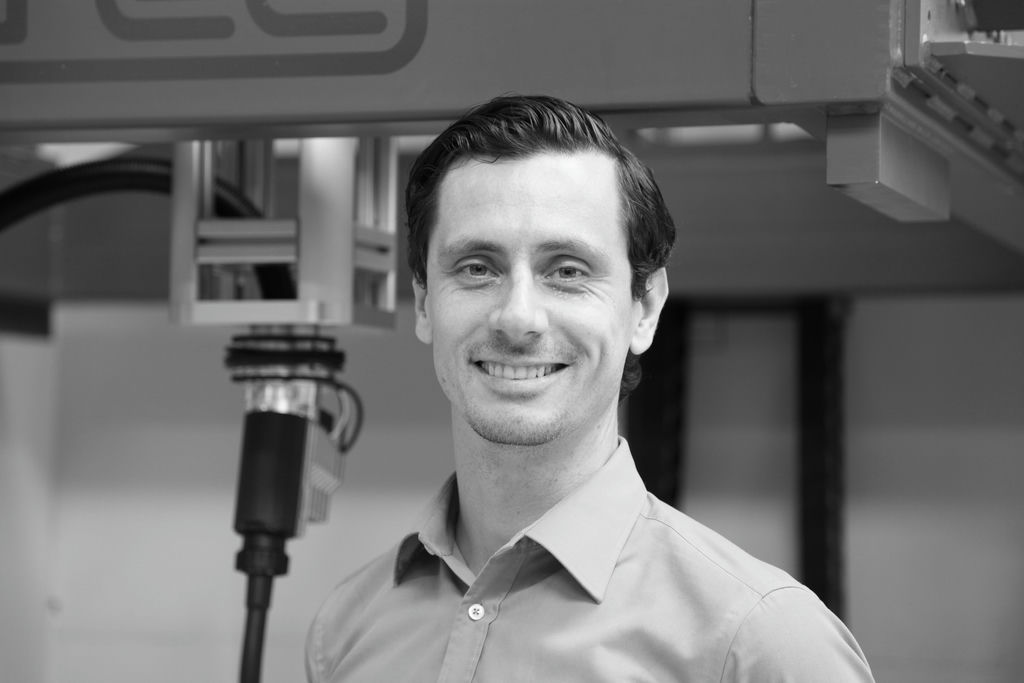GEFERTEC GmbH (Berlin) is making new inroads in Metal AM: with arc welding, 5-axis-machines weld wires layer by layer onto each other. The blanks produced in this way are near-net-shape, thus minimizing time and tool effort in milling postprocessing. In this interview, manager Tobias Röhrich explains the existing range of materials, why a new design is not necessarily indispensable, and how he imagines a fully automated additive process chain.
Could you provide a short introduction to GEFERTEC GmbH?

Tobias Röhrich: I co-founded GEFERTEC at the beginning of 2015 with my colleague Georg Fischer. We met as research assistants at the TU Berlin. It all began with the question why all manufacturers of additive manufacturing systems in the metal sector relied on powderbed technology. We both have a background in welding technology, and we knew about the advantages of wire. First attempts showed that a layered construction of components consisting of wire works well. As lasers do not give much advantage here, we switched to the cost-efficient, uncomplicated arc-welding. We then began with founding our company, and we found a strong partner in the Scansonic Group. Last autumn, we presented our system at the EMO, and it is already in use with our first customers.
[ihc-hide-content ihc_mb_type=”show” ihc_mb_who=”reg” ihc_mb_template=”3″ ]
Which parts of additive manufacturing do you target as a system manufacturer?
Röhrich: Our customers stem from different sectors. As our technology is suitable for fast construction of large parts as well, there is a high demand in tool and mold construction, where they use it to produce molding dies, molding tools, and die casting tools. In addition, the aviation sector is interested, as they want to manufacture large titanium components cost-efficiently. We have also registered a lot of interest in general mechanical engineering and in job shops. The customer range includes small medium-sized businesses as well as global corporations.
Which range of materials can users process in your systems?
Röhrich: Nearly all weldable wires. There is a broad range of aluminium alloys, titanium, nickel, and copper base alloys and diverse steels, from construction steel for less than one euro per kilo, high-alloyed stainless steels up to tool steels. There are several hundred alloys on offer as welding wire. The more expensive and the harder it is to machine the material, the more interesting our technology becomes to customers as we produce near-net-shape blanks that do not need full-on milling, only the final contour needs to be cut out. This is why we in German like to call our semi-finished products “seven-eighths finished products”, as they are nearly finished, not just semi-finished. Whereas traditionally you had to do mechanical work, milling, and sawing, with our technology we offer a time-, resource-, and energy-efficient alternative that also minimizes tool wear and tear. And as opposed to other additive technologies, all these advantages can be gained with traditional construction where thinking is done as it is in machining. In order to be able to build even complex parts, the welding process happens in a 5-axis-CNC machine. The wire is moved across the X, Y, and Z axis while the component rests on a rotary tilting table. In this way, you can realize any shape including overhangs – without any supporting structures.
Where do you differ from other market players?
Röhrich: There is no other supplier relying on our arc-welding-wire process who could also deliver an immediately serviceable machine including CAM software. And as I said, there is no need for an additive new construction for better profit. This means we are moving within a completely different market segment compared to suppliers of powderbed systems. In addition, even large components can be realized quickly. We process wires with a strength from 0.8 to 1.6 mm, although it is usually 1.0 to 1.2 mm. The advantage in this is: the materials are standardized, certified for different sectors, and the technology itself is based on established welding technology including diverse process gases, in order to optimize the process for each alloy. Another difference: our technology is most interesting for components with a minimum volume of one liter.
Where do you see the biggest technological challenges in system technology?
Röhrich: On the one hand, it is all about faster build-up rates. On the other hand, we are working on integrating milling technology into our machines for processing of ducts and hollow spaces that cannot be reached during post-processing. And we are working on topics related to Industrie 4.0, for example on using data from the welding process for a more efficient design of the additive build-up process.
The industry wishes for automated process chains that would combine manufacturing and postprocessing technologies of diverse manufacturers via plug & play. In your view, is this wish realistic?
Röhrich: The process chain is a deciding factor for success. Our advantage is in using the same control and software tools as in postprocessing systems. This means that closed data and process chains from CAD construction up to machining processing of our blanks are comparably easy to achieve. In my imagination of the future, there will be three to four specimens of our machines standing all around one milling machine, and there will be robots to pick up our finished “seven-eighths products” and place them at the milling machine. This would minimize down time of the milling systems, and our systems could work all around the clock.
[/ihc-hide-content]



